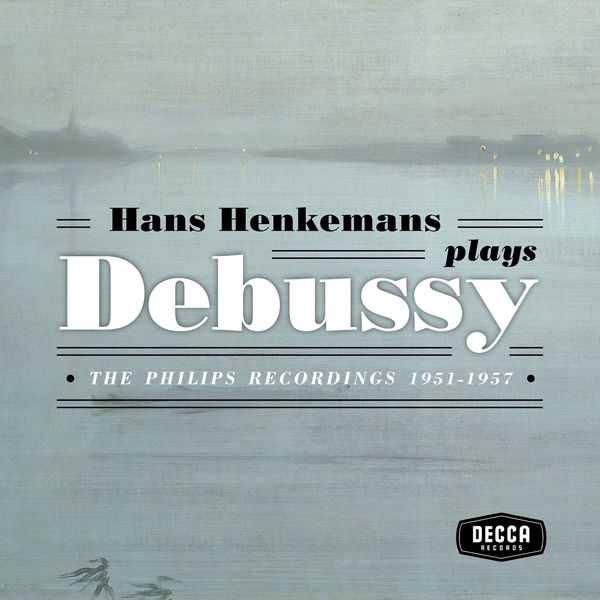

Composer: Claude Achille Debussy
Performer: Hans Henkemans
Format: FLAC (tracks)
Label: Decca
Catalogue: 4829490
Release: 2018
Size: 1.31 GB
Recovery: +3%
Scan: yes
Préludes / Book 1, L.117
01. 1. Danseuses de Delphes
02. 2. Voiles
03. 3. Le vent dans la plaine
04. 4. Les sons et les parfums tournent dans l’air du soir
05. 5. Les collines d’Anacapri
06. 6. Des pas sur la neige
07. 7. Ce qu’a vu le vent d’ouest
08. 8. La fille aux cheveux de lin
09. 9. La sérénade interrompue
10. 10. La cathédrale engloutie
11. 11. La danse de Puck
12. 12. Minstrels
Préludes – Book 2, L.123
13. 1. Brouillards
14. 2. Feuilles mortes
15. 3. La puerta del vino
16. 4. “Les fées sont d’exquises danseuses”
17. 5. Bruyères
18. 6. “General Lavine” – eccentric
19. 7. La terrasse des audiences du clair de lune
20. 8. Ondine
21. 9. Hommage à S. Pickwick, Esq., P.P.M.P.C.
22. 10. Canope
23. 11. Les tierces alternées
24. 12. Feux d’artifice
12 Etudes, L.136
25. 1. Pour les “cinq doigts” (d’après Monsieur Czerny)
26. 2. Pour les Tierces
27. 3. Pour les Quartes
28. 4. Pour les Sixtes
29. 5. Pour les Octaves
30. 6. Pour les huit doigts
31. 7. Pour les Degrés chromatiques
32. 8. Pour les Agréments
33. 9. Pour les Notes répétées
34. 10. Pour les Sonorités opposées
35. 11. Pour les Arpèges composés
36. 12. Pour les Accords
Images – Book 1, L. 110
37. 1. Reflets dans l’eau
38. 2. Hommage à Rameau
39. 3. Mouvement
Images – Book 2, L. 111
40. 1. Cloches à travers les feuilles
41. 2. Et la lune descend sur le temple qui fût
42. 3. Poissons d’or
Deux Arabesques L. 66
43. No. 1 Andante con moto
44. No. 2 Allegretto scherzando
Tarentelle styrienne (Danse), L.77a
45. Tarentelle styrienne (Danse), L.77a
Ballade slave, L.70
46. Ballade slave, L.70
Mazurka, L. 67
47. Mazurka, L. 67
48. Rêverie, L.76
Valse romantique, L. 71
49. Valse romantique, L. 71
Suite Bergamasque, L.75
50. 1. Prélude
51. 2. Menuet
52. 3. Clair de lune
53. 4. Passepied
Pour le piano, L. 95
54. 1. Prélude
55. 2. Sarabande
56. 3. Toccata
La plus que lente, L.121
57. La plus que lente, L.121
Estampes, L. 100
58. 1. Pagodes
59. 2. Soirée dans Grenade
60. 3. Jardins sous la pluie
Children’s Corner, L.113
61. 1. Doctor Gradus Ad Parnassum
62. 2. Jimbo’s Lullaby
63. 3. Serenade For The Doll
64. 4. The Snow Is Dancing
65. 5. The Little Shepherd
66. 6. Golliwog’s Cakewalk
L’Isle joyeuse, L. 109
67. L’Isle joyeuse, L. 109
Masques, L. 105
68. Masques, L. 105
Hommage à Haydn, L. 115
69. Hommage à Haydn, L. 115
Berceuse héroïque, L. 132
70. Berceuse héroïque, L. 132
D’un cahier d’esquisses, L. 99
71. D’un cahier d’esquisses, L. 99
A brainchild of two veterans of the Philips label – including Tom Deacon, the instigator of the phenomenal “The Great Pianists of the 20th Century” in the 1990s – this re-release of the recordings of the complete works of Debussy played by Hans Henkemans for the Dutch label from 1951 to 1957 will remain one of the most beautiful celebrations marking this centenary year. These historic recordings, which have yet to be released as a single collection, were made at about the same time as the recordings by Marcelle Meyer (Les Discophiles Français), Albert Ferber (Ducretet-Thomson), Walter Gieseking (His Master’s Voice), Menahem Pressler (MGM Records) and Reine Gianoli (Westminster): but they stand out from their contemporaries for their concern for textual precision and above all a complete absence of impressionism. The composer Hans Henkeman, born in 1913 and a major figure in the musical life of the Netherlands from the 1930s to the 1960s, was mainly interested in the range of the French composer’s rhythmic vocabulary.
Very often, and in particular in modern cycles (Estampes, Images, Children’s Corner), the rhythm seems to overshadow the purely harmonic aspect, even if Hans Henkemans’ naturally clear and limpid piano playing style reproduces these elements of Debussy’s musical world without adulteration. Reflets dans l’eau stuns with its rapid tempo, its somewhat pithy expressiveness, but also with its fiery surges, its powerful accents in the fortissimo passages: there is also a freedom, a great broadness, in Henkemans’ piano, which lends an almost austere aspect to the music’s overall rhythmic stature. Moreover, Cloches à travers les feuilles, the greatest and also the most difficult of the Images pour piano, surprises the listener as much for its variations at a fulgurating tempo as for the great clarity of its articulation. But for many, the best of Henkemans’ treasury of Debussy remains the 12 Etudes, where, naturally, his strict and utterly original playing style is perfectly matched to this mature, extreme cycle. Few musicians have brought such speed to Pour les degrés chromatiques or such a rage to Pour les agréments. Stunning!
As Tom Deacon quite rightly puts it in the liner notes, “these interpretations can and should be seen as the forerunners of the modern approach to Debussy represented by the late Charles Rosen, Arturo Benedetti Michelangeli, and even the young Michel Béroff as well as by the conductor Pierre Boulez, all of whom worked to strip the carbuncles from Debussy’s music that are simply the result of the normal wear and tear of successive generations of mis(or should I say over-)interpretations. This re-release should really set the record straight.